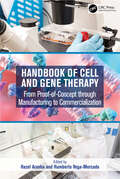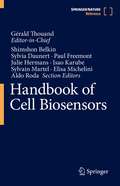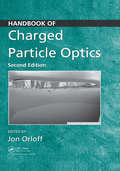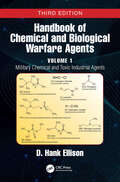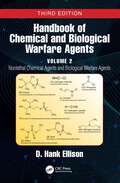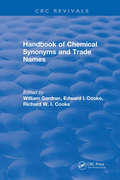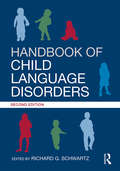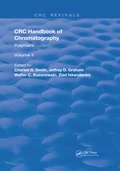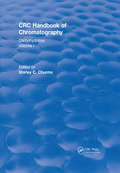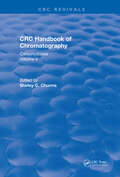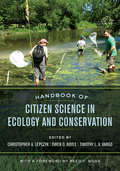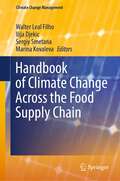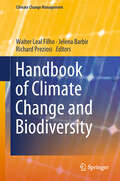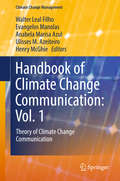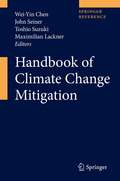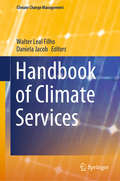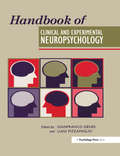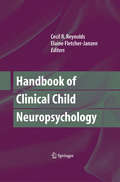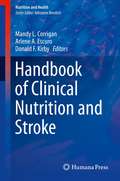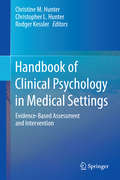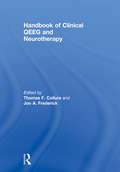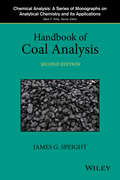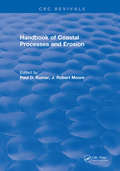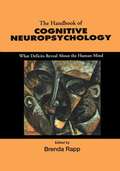- Table View
- List View
Handbook of CCD Astronomy
by Steve B. HowellCharge-Coupled Devices (CCDs) are the state-of-the-art detector in many areas of observational science. Astronomy, physics, chemistry, medical imaging, and remote sensing are just a few of the fields of study in which they play a crucial role. This handbook provides a concise and accessible reference on all practical aspects of using CCDs. Starting with the electronic workings of CCDs, this handbook discusses their basic characteristics and then gives methods and examples of how to determine these values. While the focus of the book is on the use of CCDs in professional observational astronomy, advanced amateur astronomers, and researchers in physics, chemistry, medical imaging, and remote sensing will also find it very valuable. Tables of useful and hard-to-find data, and key practical equations round off the book and ensure that it provides an ideal introduction to the practical use of CCDs for graduate students, and a handy reference for more experienced users.
Handbook of Cell and Gene Therapy: From Proof-of-Concept through Manufacturing to Commercialization
by Hazel Aranha Humberto Vega-MercadoThis handbook provides an in-depth review of information across the developmental spectrum of gene and cell therapy products. From introductory information to state-of-the-art technologies and concepts, the book provides insights into upstream processes such as vector design and construction, purification, formulation and fill/finish as well as delivery options. Planning steps for compliance with current good manufacturing practice (CGMP) to readiness for chemistry, manufacturing, and controls (CMC) are also discussed.This book wraps up with examples of successes and pitfalls addressed by experts who have navigated the multiple challenges that are part of any innovative endeavor. Features Intended as a one-stop resource for availability of state-of-the-art information related to cell and gene therapy products for researchers, scientists, management and other academic and research institutions. Provides the most up to date information on the development of gene therapy, from the technology involved to gene correction and genome editing. Discusses siRNA, mRNA, and plasmid manufacturing. Describes the importance of supplier-sponsor synergies on the path to commercialization. Diverse audience with a large number of individuals in the core technologies and supportive practices.
Handbook of Cell Biosensors
by Shimshon Belkin Sylvia Daunert Paul Freemont Julie Hermans Isao Karube Sylvain Martel Elisa Michelini Aldo RodaThis handbook is an interdisciplinary and comprehensive reference covering all aspects of cell biosensors. It is divided into four main sections which are led and organized by numerous international experts. The scope of coverage includes: Fundamentals and genetics for biosensor applicationsTransducers, Materials and SystemsMarkets, innovation and educationApplication of biosensors in business Biosensor research is an exciting hybrid world where biologists, chemists, physicists, engineers and computer engineers come together. This handbook will serve as an invaluable living resource for all researchers in academia and industry working with cell biosensors.
Handbook of Charged Particle Optics
by Jon OrloffWith the growing proliferation of nanotechnologies, powerful imaging technologies are being developed to operate at the sub-nanometer scale. The newest edition of a bestseller, the Handbook of Charged Particle Optics, Second Edition provides essential background information for the design and operation of high resolution focused probe instruments. The book’s unique approach covers both the theoretical and practical knowledge of high resolution probe forming instruments. The second edition features new chapters on aberration correction and applications of gas phase field ionization sources. With the inclusion of additional references to past and present work in the field, this second edition offers perfectly calibrated coverage of the field’s cutting-edge technologies with added insight into how they work. Written by the leading research scientists, the second edition of the Handbook of Charged Particle Optics is a complete guide to understanding, designing, and using high resolution probe instrumentation.
Handbook of Chemical and Biological Warfare Agents, Volume 1: Military Chemical and Toxic Industrial Agents (Handbook Chemical & Biological Warfare Agents 3e)
by D. Hank EllisonThe Handbook of Chemical and Biological Warfare Agents, Volume 1: Military Chemical and Toxic Industrial Agents, Third Edition provides rapid access to key data to response professionals and decision-makers on a broad range of agents and pathogens. This volume examines military chemical agents that were developed for their lethal effects and includes chapters on nerve agents, vesicants, urticants, convulsants, blood agents, and pulmonary agents. It also details toxic industrial materials that are considered potential threat for use as improvised agents. In addition to a discussion of each of these classes of agents, coverage includes detailed information on a broad spectrum of individual agents that have been used on the battlefield, stockpiled as weapons, used or threatened to be used by terrorists, or have been otherwise assessed by qualified law enforcement and response organizations and determined to be agents of significant concern The information presented in this edition has been updated and expanded; containing more information on toxicology, health effects, chemical and physical properties of individual agents, as well as protective actions needed at the scene of an incident. Key Features: Focuses on key information needed during an emergency response Provides updated toxicology, exposure hazards, physical-chemical data, and best practices with regard to the treatment of casualties Presents updated protective action distances, decontamination, and remediation information All data compiled is gathered from numerous sources and arranged into the current, easy-to-access format. In order to ensure accuracy, all data has been cross-checked over the widest variety of military, scientific and medical sources available. The Handbook of Chemical and Biological Warfare Agents, Volume 1: Military Chemical and Toxic Industrial Agents, Third Edition remains the gold-standard reference detailing the widest variety of military, scientific, and medical sources available
Handbook of Chemical and Biological Warfare Agents, Volume 2: Nonlethal Chemical Agents and Biological Warfare Agents (Handbook Chemical & Biological Warfare Agents 3e)
by D. Hank EllisonThe Handbook of Chemical and Biological Warfare Agents, Volume 2: Pathogens, Mid-Spectrum, and Incapacitating Agents, Third Edition provides rapid access to key data to response professionals and decision-makers on a broad range of agents and pathogens. This volume presents information on a wide range of chemical and biological agents. Chemical agents detailed in this volume are those that were developed specifically for their non-lethal potential. The biological agents described are militarily significant pathogens that could be weaponized to pose a threat to people, animals, or crops and other agricultural interests. Mid-spectrum agents, materials that do not fit clearly into either the Chemical or the Biological Weapons Conventions, include toxins and bioregulators. Entomological agents, the final class of agents discussed in volume, are arthropods that could pose a significant threat to a country’s agriculture infrastructure and be used to devastate its economy. They were proposed for inclusion in the Biological Weapons Convention but never adopted. In addition to a discussion of each of these classes of agents, coverage includes detailed information on a broad spectrum of individual agents that have been used on the battlefield, stockpiled as weapons, used or threatened to be used by terrorists, or have been otherwise assessed by qualified law enforcement and response organizations and determined to be agents of significant concern. The information presented in this edition has been updated and expanded to contain more information on toxicology, health effects, presentation of diseases, advances in medical care and treatment, as well as protective actions needed at the scene of an incident. Key Features: Focuses on the key information needed during an emergency response Provides updated toxicology, exposure hazards, physical-chemical data, and treatment of casualties Profiles the presentation of diseases in people, animals and plants Presents updated protective action distances, decontamination, and remediation information All data compiled is gathered from numerous sources and arranged into the current, easy-to-access format. In order to ensure accuracy, all data has been cross-checked over the widest variety of military, scientific and medical sources available. The Handbook of Chemical and Biological Warfare Agents, Volume 2: Pathogens, Mid-Spectrum, and Incapacitating Agents, Third Edition remains the gold-standard reference detailing the widest variety of military, scientific, and medical sources available.
Handbook of Chemical Synonyms and Trade Names
by William Gardner, Edward I. Cooke and Richard W. I. CookeTo this Eighth Edition of the late Mr William Gardner‘s Chemical Synonyms and trade Names there have been added some 3,300 new entries, principally in the field of plastics, alloys and pharmaceuticals. A number of entries describing products known to the Editors to be no longer commercially available have been deleted, with the principal object of keeping the bulk of the book within reasonable bounds; but it has been possible to add nearly 400 names to the Index of Manufacturers to be found at the end of the book. The sum of these additions and deletions represents a net increase of about 10 per cent, in the scope of this Eighth Edition as compared with its predecessor published in 1971.
Handbook of Child Language Disorders: 2nd Edition
by Richard G. SchwartzThe acquisition of language is one of the most remarkable human achievements. When language acquisition fails to occur as expected, the impact can be far-reaching, affecting all aspects of the child’s life and the child’s family. Thus, research into the nature, causes, and remediation of children’s language disorders provides important insights into the nature of language acquisition and its underlying bases and leads to innovative clinical approaches to these disorders. This second edition of the Handbook of Child Language Disorders brings together a distinguished group of clinical and academic researchers who present novel perspectives on researching the nature of language disorders in children. The handbook is divided into five sections: Typology; Bases; Language Contexts; Deficits, Assessment, and Intervention; and Research Methods. Topics addressed include autism, specific language impairment, dyslexia, hearing impairment, and genetic syndromes and their deficits, along with introductions to genetics, speech production and perception, neurobiology, linguistics, cognitive science, and research methods. With its global context, this handbook also includes studies concerning children acquiring more than one language and variations within and across languages. Thoroughly revised, this edition offers state-of-the-art information in child language disorders together in a single volume for advanced undergraduate students and graduate students. It will also serve as a valuable resource for researchers and practitioners in speech-language pathology, audiology, special education, and neuropsychology, as well as for individuals interested in any aspect of language acquisition and its disorders.
Handbook of Chromatography: Volume II: Polymers
by Charles G. SmithHandbook of Chromatography features tables and chromatograms, theoretical discussions, and practical applications on the topic. Tables and chromatograms are based on polymer analyses abstracted from literature references dating from 1981-1991. Compounds presented in the tables and chromatograms include residual monomers, plasticizers, additives, antioxidants, and products from the thermal degradation (pyrolysis) of a broad range of synthetic polymers. Theoretical discussions focus on new developments in the respective areas of gas, pyrolysis-gas, liquid, and size exclusion chromatographic separations. Capillary column technology, inverse gas chromatography (IGC), supercritical fluid extractions (SFE), and supercritical fluid chromatography (SFC) are also covered. A Practical Applications subsection provides a list of commercial suppliers of column packings and packed columns for gas and liquid chromatography. The book will be an excellent reference for chromatographers, organic chemists, and analytical chemists.
Handbook of Chromatography Vol I: Carbohydrates (CRC Press Revivals)
by Shirley C. ChurmsThis handbook is intended to serve as a working manual and reference book for carbohydrate chemists and biochemists using the chromatographic methods that are indispensable in this field. Emphsis is on newer methods, such as high-performance liquid chromatography (HPLC) and other automated liquid chromatography systems; and the material included was compiled mainly from literature published during the years 1970 to 1978. Data appearing in Volumes I and II of the Handbook of Chromatography are not repeated here, but references to relevant tables in Volumes I and II are given at the start of corresponding sections of this handbook. In some cases material published before 1970 that was omitted from Volumes I and II of the series is included here: this applies particularly to the sections dealing with paper chromatography and electrophoresis.
Handbook of Chromatography Volume II: Carbohydrates (CRC Press Revivals)
by Joseph Sherma Shirley C. ChurmsCRC Handbook of Chromatography: Carbohydrates, Volume II updates the first volume, continuing coverage of literature published from 1979 to 1989. Tabulated for easy reference and thoroughly documented, it presents the comprehensive data for all chromatographic techniques applicable to carbohydrates. It features glycoproteins, proteoglycans, and glycolipids, as well as mono-, oligo-, and polysaccharides. This important text emphasizes novel chromatographic methods. Highlights of this superb work include the diversity of HPLC methods applicable to carbohydrates, and the use of some new techniques, including supercritical fluid chromatography and ion chromatography in carbohydrate analysis. Readers discover the latest detection methods, degradative processes, and derivatization techniques. Detailed chapters cover topics such as spectroscopic techniques, electrochemistry, and gas chromatography. This easy-to-use volume provides an excellent working manual and reference book for researchers in the fields of carbohydrate chemistry and biochemistry. CRC Handbook of Chromatography, Carbohydrates: Volume II is an absolute must for all analysts working for industries concerned with carbohydrates.
Handbook of Citizen Science in Ecology and Conservation
by Christopher A. Lepczyk Owen D. Boyle Timothy L. V. VargoHandbook of Citizen Science in Ecology and Conservation is the first practical and comprehensive manual for creating, implementing, or improving natural science research and monitoring projects that involve collaboration between scientists and the general public. As citizen science projects become increasingly common, project leaders are seeking information on concrete best practices for planning and implementing projects—practices that allow them to guide and gauge success while also ensuring the collection of high-quality data and rewarding experiences for volunteers. In this handbook, citizen science practitioners from around the world and with decades of experience provide step-by-step instructions, insights, and advice, and they explore real-world applications through case studies from a variety of citizen science projects. This is the definitive reference guide for anyone interested in starting or improving a citizen science project with ecological or conservation applications, from professors and graduate students to agency staff and nongovernmental organizations.
Handbook of Climate Change Across the Food Supply Chain (Climate Change Management)
by Walter Leal Filho Marina Kovaleva Ilija Djekic Sergiy SmetanaThis book presents climate change as a global phenomenon which affects the entire food chain. Many studies analyzing environmental impacts of food systems confirm significant effects of food production on climate change. Most of them associate primary production with emission of greenhouse gasses identified as one of the causes resulting in warming the atmosphere and global climate effects. A wider perspective shows that the food chains start at farms with consumers being at the end of the pipeline. This approach emphasizes the role of the entire food chain highlighting different kinds of environmental impacts affecting climate change. On the other side, temperature changes and variations of precipitation patterns, together with extreme weather events and water reduction, are recognized as predictors for producing less food, decreased food quality, new food safety risks, biodiversity losses, and depletion of resources associated with food production in modified circumstances. Last but not least, these effects introduce new threats known as food security where some assumptions stress that almost one billion of people are hungry not receiving enough food as a result of climate changes. As a result, the UN highlights the need for combating climate change and promotes sustainable (food) consumption and production. Based on the perceived need to promote and disseminate information on climate change related to food system, the “Handbook of Climate change across the food supply chain” is being produced. The publication compiles information, experiences, practical initiatives, and projects around the subject matter and makes it available to a wide audience. It is expected that the “Handbook of Climate change across the food supply chain” makes many benefits of climate service clearer and, inter alia, leads to an increase in the demand for such important services.
Handbook of Climate Change and Biodiversity (Climate Change Management Ser.)
by Richard Preziosi Jelena Barbir Walter Leal FilhoThis book comprehensively describes essential research and projects on climate change and biodiversity. Moreover, it includes contributions on how to promote the climate agenda and biodiversity conservation at the local level. Climate change as a whole and global warming in particular are known to have a negative impact on biodiversity in three main ways. Firstly, increases in temperatures are detrimental to a number of organisms, especially those in sensitive habitats such as coral reefs and rainforests. Secondly, the pressures posed by a changing climate may lead to sets of responses in areas as varied as phenology, range and physiology of living organisms, often leading to changes in their lifecycles (especially but not only in reproduction), losses in productivity or even death. In some cases, the very survival of very sensitive species may be endangered. Thirdly, the impacts of climate change on biodiversity will be felt in the short term with regard to some species and ecosystems, but also in the medium and long term in many biomes. Indeed, if left unchecked, some of these impacts may be irreversible. Many individual governments, financial institutes and international donors are currently spending billions of dollars on projects addressing climate change and biodiversity, but with little coordination. Quite often, the emphasis is on adaptation efforts, with little emphasis on the connections between physio-ecological changes and the lifecycles and metabolisms of fauna and flora, or the influence of poor governance on biodiversity. As such, there is a recognized need to not only better understand the impacts of climate change on biodiversity, but to also identify, test and implement measures aimed at managing the many risks that climate change poses to fauna, flora and micro-organisms. In particular, the question of how to restore and protect ecosystems from the impact of climate change also has to be urgently addressed. This book was written to address this need. The respective papers explore matters related to the use of an ecosystem-based approach to increase local adaptation capacity, consider the significance of a protected areas network in preserving biodiversity in a changing northern European climate, and assess the impacts of climate change on specific species, including wild terrestrial animals. The book also presents a variety of case studies such as the Yellowstone to Yukon Conservation Initiative, the effects of climate change on the biodiversity of Aleppo pine forest in Senalba (Algeria), climate change and biodiversity response in the Niger Delta region, and the effects of forest fires on the biodiversity and the soil characteristics of tropical peatlands in Indonesia. This is a truly interdisciplinary publication, and will benefit all scholars, social movements, practitioners and members of governmental agencies engaged in research and/or executing projects on climate change and biodiversity around the world.
Handbook of Climate Change Communication: Vol. 1
by Walter Leal Filho Evangelos Manolas Anabela Marisa Azul Ulisses M. Azeiteiro Henry McGhieThis comprehensive handbook provides a unique overview of the theory, methodologies and best practices in climate change communication from around the world. It fosters the exchange of information, ideas and experience gained in the execution of successful projects and initiatives, and discusses novel methodological approaches aimed at promoting a better understanding of climate change adaptation. Addressing a gap in the literature on climate change communication and pursuing an integrated approach, the handbook documents and disseminates the wealth of experience currently available in this field. Volume 1 of the handbook provides a unique description of the theoretical basis and of some of the key facts and phenomena which help in achieving a better understanding of the basis of climate change communication, providing an essential basis for successful initiatives in this complex field.
Handbook of Climate Change Mitigation
by Maximilian Lackner Toshio Suzuki Wei-Yin Chen John SeinerThere is a mounting consensus that human behavior is changing the global climate and its consequence could be catastrophic. Reducing the 24 billion metric tons of carbon dioxide emissions from stationary and mobile sources is a gigantic task involving both technological challenges and monumental financial and societal costs. The pursuit of sustainable energy resources, environment, and economy has become a complex issue of global scale that affects the daily life of every citizen of the world. The present mitigation activities range from energy conservation, carbon-neutral energy conversions, carbon advanced combustion process that produce no greenhouse gases and that enable carbon capture and sequestion, to other advanced technologies. From its causes and impacts to its solutions, the issues surrounding climate change involve multidisciplinary science and technology. This handbook will provide a single source of this information. The book will be divided into the following sections: Scientific Evidence of Climate Change and Societal Issues, Impacts of Climate Change, Energy Conservation, Alternative Energies, Advanced Combustion, Advanced Technologies, and Education and Outreach.
Handbook of Climate Services (Climate Change Management)
by Walter Leal Filho Daniela JacobThis book explores climate services, including projections, descriptive information, analyses, assessments, and an overview of current trends. Due to the pressures now being put on the world’s climate, it is vital to gather and share reliable climate observation and projection data, which may be tailored for use by different groups. In other words, it is essential to offer climate services. But despite the growth in the use of these services, there are very few specialist publications on this topic. This book addresses that need. Apart from presenting studies and the results of research projects, the book also offers an overview of the wide range of means available for providing and using climate services. In addition, it features case studies that provide illustrative and inspiring examples of how climate services can be optimally deployed.
Handbook Of Clinical And Experimental Neuropsychology
by Gianfranco Denes Luigi PizzamiglioThe domain of neuroscience has had one of the most explosive growths in recent decades: within this development there has been a remarkable and renewed interest in the study of the relations between behaviour and the central nervous system. Part of this new attention is connected with the contribution of new technologies (PET, fMRI) permitting more precise mapping of neural structures responsible for cognitive functions and the development of new theoretical models of mental activities.The diffusion of new pathologies (for example the pattern of cognitive impairment associated with AIDS) has further enlarged the field of clinical neuropsychology. Finally there has been an expanding clinical interest in the understanding and management of age-related cognitive changes.This volume is the translated and updated version of the second edition of Manuale di Neuropsicologia (Zanichelli, 1996), by the same authors, and it reflects the current status of the art. It is intended to blend clinical and theoretical aspects of neuropsychology. The first part discusses the instrumental and clinical methods of investigation in neuropsychology, together with their development. A long section is dedicated to the language and memory disorders. The impairment of non-verbal cognitve functions, such as the disorders of space orientation, of of visuo-perceptive abilities, and of the emotions and attention, are extensively discussed. The pattern of degenerative dementias is thorougly described, as e is thoroughly described, as well as a number of new topics, such as a neuropsychological approach to consciousness. Finally, perspectives for treatment of some cognitive disorders are outlined.
Handbook of Clinical Child Neuropsychology
by Elaine Fletcher-Janzen Cecil R. ReynoldsEvery chapter has been updated to reflect current thought and research in the field. Chapters devoted to specialized tests in neuropsychology have been updated to reflect new editions of these popular instruments. Special topic chapters have been added such as working in pediatric coma rehabilitation, using the planning, attention, sequential, simultaneous theory of neuropsychological processes, additions on ADHD, and more appear written by the leading experts and practitioners in these fields to reflect the demands of current practice in clinical child neuropsychology.
Handbook of Clinical Nutrition and Stroke
by Arlene A. Escuro Donald F. Kirby Mandy L. CorriganHandbook of Clinical Nutrition and Stroke is a comprehensive reference on nutrition for the multidisciplinary team caring for stroke patients. Targeting physicians, nurse practitioners, clinical dietitians, and advanced allied health and medical students, this volume provides an introduction on the different types of stroke, associated risk factors, and uniquely featured global perspectives on stroke. In addition to discussing stroke risk factors, the book expands upon treatment and management from the acute care setting through rehabilitation, captures the lifespan of patients affected by stroke, and discusses the progression of the nutrition care plan. Containing the most up-to-date, evidence based information currently available, Handbook of Clinical Nutrition and Stroke is a valuable resource for clinicians working with the stroke population.
Handbook of Clinical Psychology in Medical Settings
by Christine M. Hunter Christopher L. Hunter Rodger KesslerGrowing recognition of the role of behavioral health in overall health, the rise of health psychology, the trend toward interdisciplinary medicine--any number of factors have made clinical psychology an integral part of integrative care. Its applicability to the range of specialties, populations, and levels of care adds to its increasing necessity in diverse healthcare settings. The Handbook of Clinical Psychology in Medical Settings emphasizes evidence-based care and practical strategies for hands-on work with patients while illuminating the unique aspects of the practice of psychology within medical settings. Skills are examined in depth for more effective work with patients, more efficient teamwork with colleagues, and better functioning within medical settings, whether readers are involved in primary, secondary, or tertiary care or prevention. Chapters also focus on ethical, legal, and financial issues, as well as changes needed in training programs to ensure that the field keeps up with the evolution of care systems and service delivery. Included in the Handbook 's forward-looking coverage: Psychology and population health. Core competencies for success in medical settings. Evidence-based practice--and practice-based evidence. Marketing health psychology, both within and outside the medical setting. Competency for diverse populations. Plus chapters devoted to specific specialties and settings, from cardiology to women's health. Comprehensive yet highly readable, the Handbook of Clinical Psychology in Medical Settings is a practice-building resource for health psychologists, clinical psychologists, and primary care physicians.
Handbook of Clinical QEEG and Neurotherapy
by Thomas F. Collura Jon A. FrederickThis book is an essential resource describing a wide range of approaches and technologies in the areas of quantitative EEG (QEEG) and neurotherapy including neurofeedback and neuromodulation approaches. It emphasizes practical, clinically useful methods, reported by experienced clinicians who have developed and used these approaches first hand. These chapters describe how the authors approach and use their particular combinations of technology, and how clients are evaluated and treated. This resource, which is encyclopedic in scope, provides a valuable and broad, yet sufficiently detailed account, to help clinicians guide the future directions in client assessment and neurotherapeutic treatment. Each contribution includes literature citations, practical information related to clinical interventions, and clinical outcome information.
Handbook of Coal Analysis
by James G. SpeightProvides users with everything they need to know about testing and analysis of coal Includes new coverage on environmental issues and regulations as related to coal Provides the reader with the necessary information about testing and analyzing coal and relays the advantages and limitations in understanding the quality and performance of coal Explains the meaning of test results and how these results can predict coal behavior and its corresponding environmental impact during use Includes a comprehensive Glossary which defines items in straightforward language that enable readers to better understand the terminology related to coal Treats issues related to sampling, and accuracy and precision of analysis
Handbook of Coastal Processes and Erosion
by Paul D. KomarThe objective of this book is to focus on the physical processes that cause coastal erosion.Many scientists and engineers have focused their research on the entire range of physical processes from the waves and the currents in the nearshore to the response of the beach, via sand transport, resulting in a changing coastal morphology. Of these many processes, this book focuses only on those which directly relate the generation of coastal erosion. Some chapters deal exclusively with the physical processes, while others provide examples of erosion problems although most of the chapter topics have clear implications for issues of coastal-zone management, these issues are not belaboured as several other books are already available in this area. The objective is to provide state-of-the-art presentation of the science of coastal erosion processes.
Handbook of Cognitive Neuropsychology: What Deficits Reveal About the Human Mind
by Brenda RappThis volume reviews the full range of cognitive domains that have benefited from the study of deficits. Chapters covered include language, memory, object recognition, action, attention, consciousness and temporal cognition.

